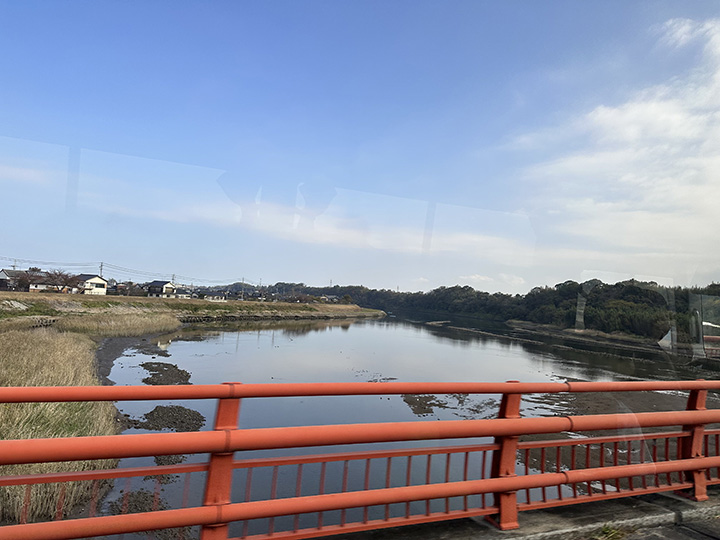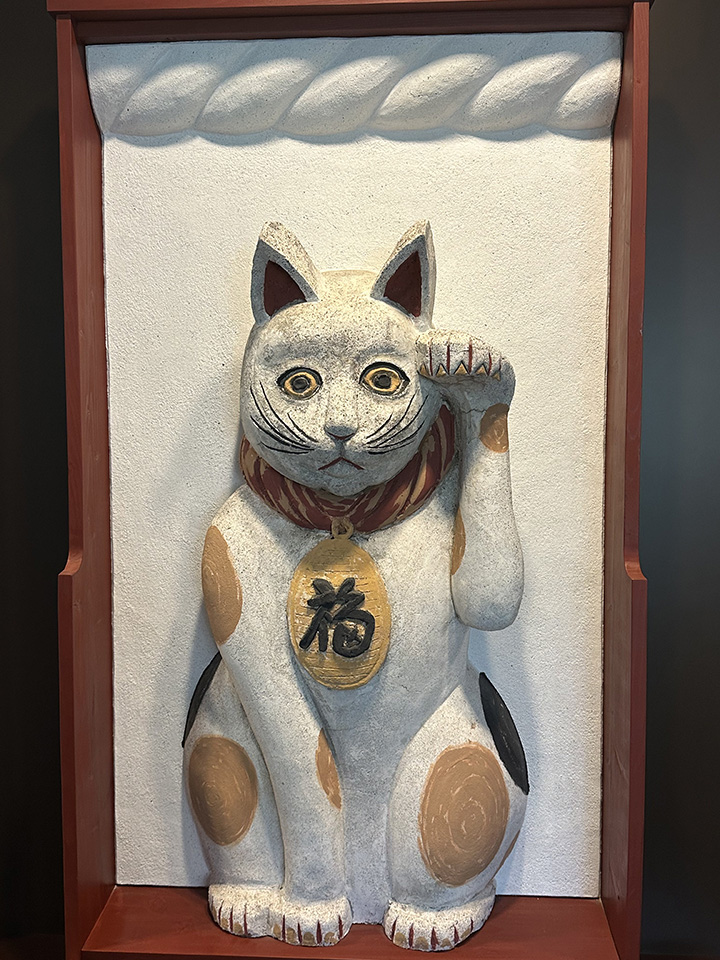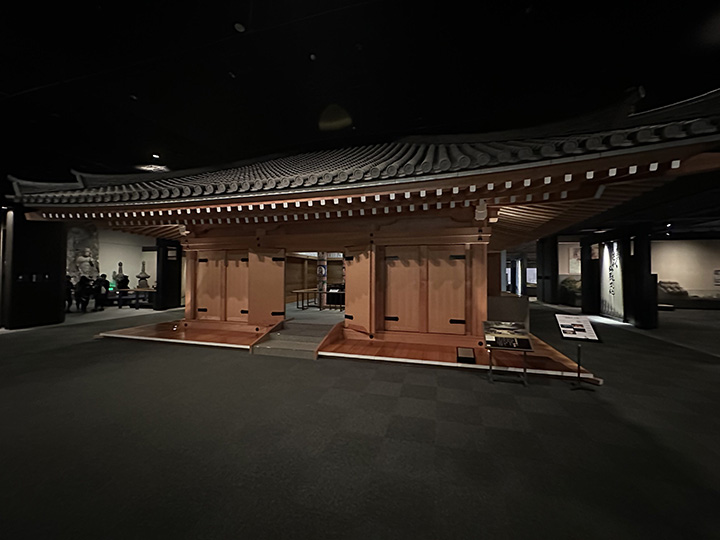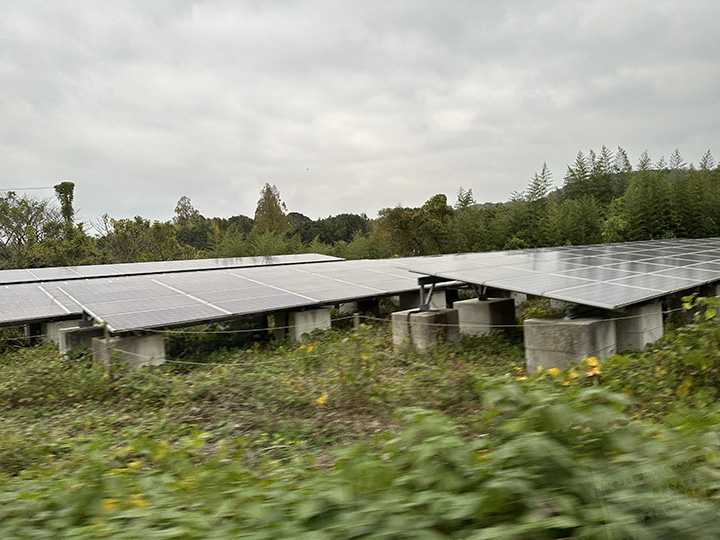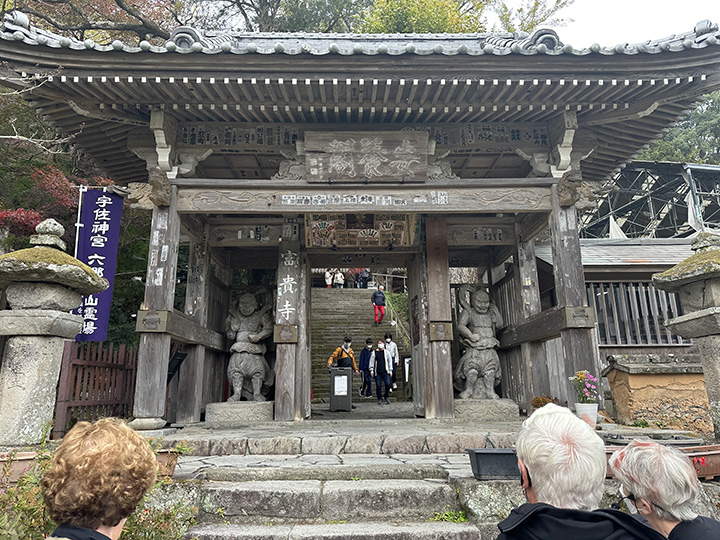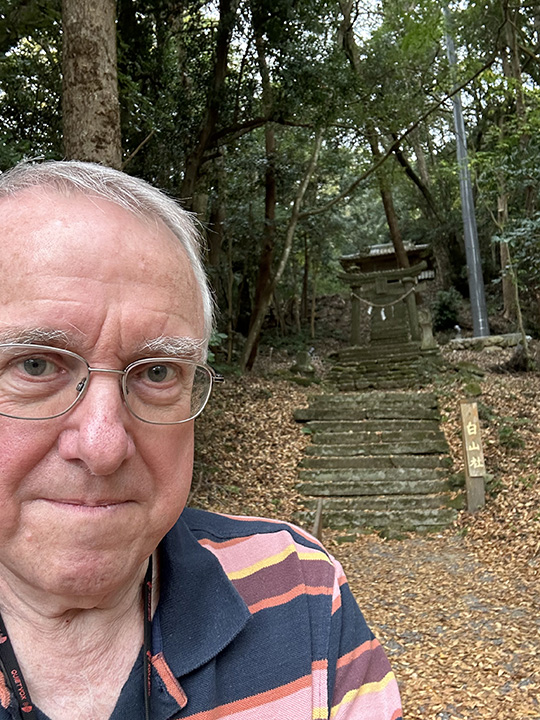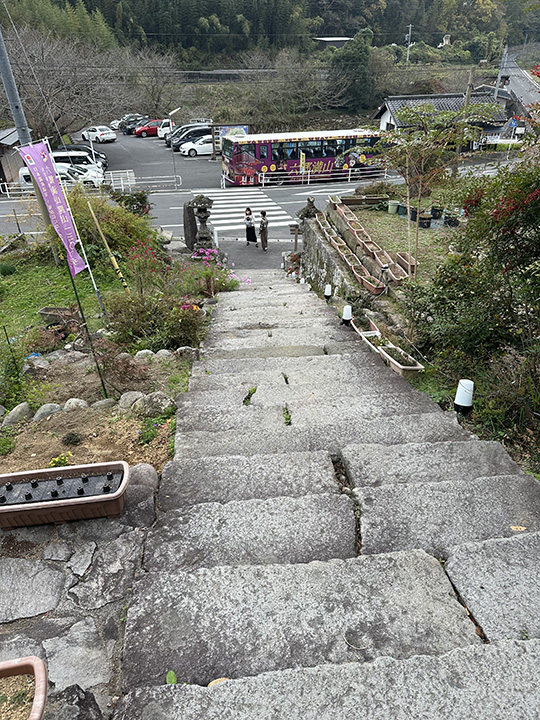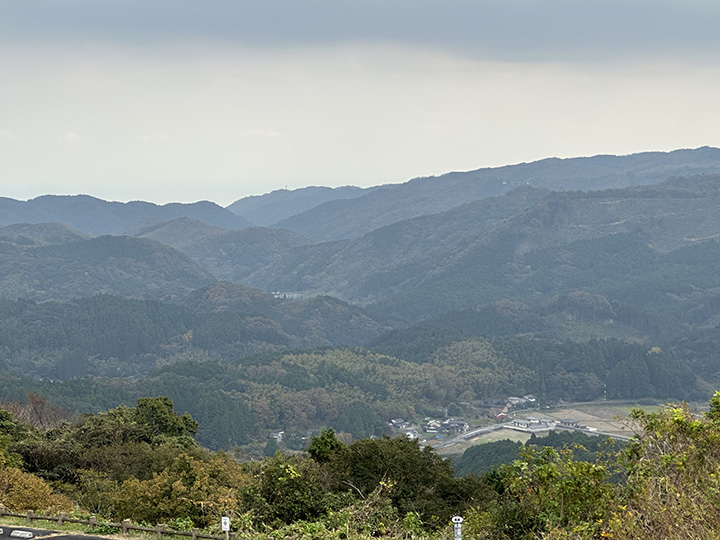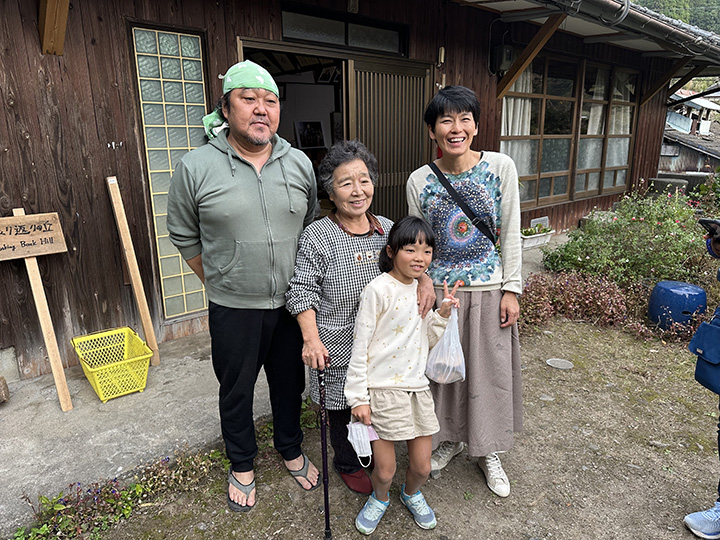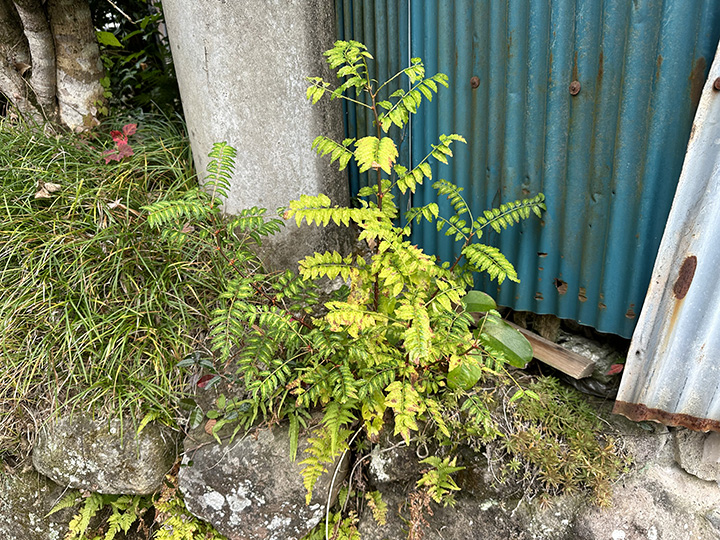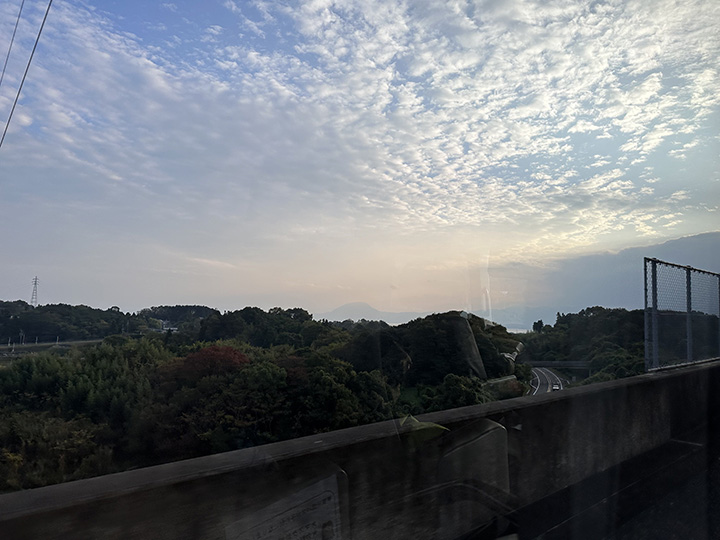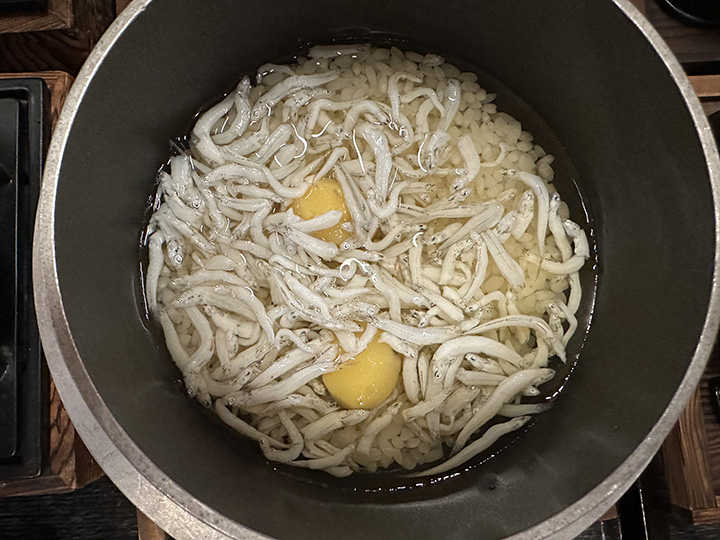|
Today I had breakfast with a robot, toured a very old Buddhist temple, visited a museum, had tea with an elderly lady in her farmhouse, and had a feast for dinner.
Our hotel in Hiroshima may have been part of the train station, but it was a very fancy hotel indeed. It even featured a robot butler who would stop by your table to take used dishes.
Bill is ready for another day’s adventure.
Say goodbye to Hiroshima
Japan rolls by.
And when we transferred at another station, say hello to a really fancy train: the Sonic Express.
Kathleen said the seats have Mickey Mouse ears.
And the seats rotate here too.
The views from the train are beginning to all look alike.
Interesting.
But not particularly remarkable. There are some mountains way back there, though.
He may have seen it all before, but he's still enjoying himself.
Where in the world are we now?
We're on a bus.
Passing bikers.
Driving through the countryside.
Headed up into the hills, I think.
The three legged mermaid on the seat back says, “fasten your seatbelt and remain seated and no smoking.” Or something like that, maybe
We are in Kunisaki, which, according to the Road Scholar information packet is a little known but fabulous area of Japan. It was one of the first Buddhist strongholds in Japan with many beautiful temples and thousands of stone Buddhas and deities spread throughout the whole area. Now we have arrived at a museum that will tell us all about it.
Well there is a stone Buddha now! It turns out that in this area there are rock faces with Buddhas like this carved into them.
The kids are here on a school field trip to learn about how the ancient Buddhas were carved into the local rock formations.
He looks impressive in this reproduction.
The whole museum is impressive.
This guy looks ferocious. He also looks like he belongs in India.
Some of the artifacts on display date back to the 1500s.
There are dolls.
And a portable shrine.
Kathleen pointed out the significance of this poster in which Shinto monks and Buddhist monks are honoring each other.
The maneki-neko (lit. 'beckoning cat') is a common Japanese figurine which is often believed to bring good luck to the owner. In modern times, they are usually made of ceramic or plastic. The figurine depicts a cat, traditionally a calico Japanese Bobtail, with a paw raised in a Japanese beckoning gesture. (The fingers are pointed down instead of upward as they would be with an American "come here" gesture.)
This is a full size mockup of a Buddhist temple.
For a moment there I had a flashback to Bhutan.
Inside the mockup.
More inside the mockup.
Some of those masks look frightening.
Yikes!
Though the overall story and appearance of the mask may seem dark, the word Hannya in Japanese actually means “wisdom” and the masks themselves are considered a symbol of good luck. In Japan today, the masks are often used as a means of warding off evil.
The diorama shows the layout of the complex.
A model of a temple.
And another Buddha.
Back in the day there were mound builders here. Reminds me of the Chickasaw Bluffs in Memphis.
And on we go in the direction of the mountains.
There are interesting sights along the way.
Farmers' fields.
Interesting that this convenience store chain uses a milk bottle and English language in the logo.
There are mountains over there, I'm sure of it.
This guy greeted us at an intersection.
The mountains are coming closer.
Will we ever get there?
Frequently we saw fields of solar panels the provide power to the communities.
Now we're in the hills.
We are about to visit Fuki-ji, one of the most picturesque temples in Japan. well, that’s what the Road Scholar information packet says.
And on our way up to see it we encounter a group of friendly Japanese tourists who would love to get their picture made with some friendly American tourists. Hi, ladies!
Fuji-ji is so popular with tourists that actual locals use this adjacent temple for worship.
Built in the year 718, the temple is Kyushu's oldest wooden building. Legend says that the temple was made from one single kaya (Japanese Torreya) tree.
There are guards at the gate.
If I were an evil deity I'd certainly be frightened away by this guy.
Kathleen pays the entrance fee.
Fuki-ji is a Tendai temple in Bungotakada, Oita Prefecture, Japan. The temple was established in 718. Its Amida-dō is generally called Fuki-ji Ō-dō. It is the oldest wooden structure in Kyushu. Ō-dō is designated a National Treasure. The seated image of the Amida-Nyōrai contained in Ō-dō is designated by the national government as an Important Cultural Property.
Up those steps are some additional sights. Should I trust my knee to take me up there?
Well of course!
There's a burial site up here.
It's all very old.
But then I had to come back down. Kathleen couldn't watch, but I made it just fine.
Fukiji Temple's Amidado hall is one of the three most important in Japan
The wooden, seated Amida Nyorai Buddha image is a designated Important Cultural Property
It's quiet and peaceful here.
There are old monuments to admire.
And beautiful fall colors to admire.
Bill is glad he came.
Time to leave.
We could go down those steps but nah...let's take the sloping path back down.
So what are those little piles of straw doing out there in the field? After I'd snapped the picture I asked Kathleen what they were and she didn't know what I was talking about. Since we were moving along in the bus it was too late to show her then and I never got around to showing her this pic on my phone. So I still don't know what they are. Kathleen, if you ever see this, please send me a note if you know what they are. Thanks.
Finally we are in the mountains.
See? Told you.
But where in the mountains, exactly?
This is a retreat area that features overnight cabins, an observatory, and a dining hall where we heard a presentation on this area, which is known as Kunisaki. I have tried diligently to learn the name of the observatory and/or the name of the camp that contains it here. The best I have been able to come up with is "Yokodake Nature Park" which I translated by zooming in on that purple sign. The blue part of the sign on the observatory translates to "Observatory Yokodake Kirarakan" but I can't find it on the internet. So I don't know where we are here. Kathleen or Kaori, if you ever see this please send me some info on the place. It seems a very nice mountain retreat, but I can find no information about it online.
There's the back side of the observatory.
And here's the inside of the lodge where we will receive a briefing on life in the local area. See those boxes on the table?
They are called "bento" boxes and they are our lunch.
Scott is beginning to look hungry.
This is Mario, an employee of Walk Japan, the company that has contracted with Road Scholar to conduct our tour. He's explaining what's in the bento box.
There it is...lunch. Yum.
Mario seems to be enjoying it.
I think the seaweed wrapped with a bow knot was a nice feature.
The dining hall was rustic.
Those logs are not going anywhere.
Mario's parents are American citizens living in Japan. He was born in Japan because his parents moved here for graduate study and liked it so much they decided to stay and raise a family. His presentation on this area was fascinating.
We were pretty high in the hills.
Let’s go visit a local family. The visit is the kind of things Road Scholar likes to work into tours. These visits give us a better idea of what life is like in local homes.
And admire the scenery along the way.
This farmhouse and the surrounding farm are owned by an octogenarian lady.
And there she is. She welcomed us into her home.
Mario helped with the serving.
We had tea and cookies.
And local tangerines.
She was a terrific hostess.
Warm and attentive.
Sitting on the floor has not become second nature yet.
Mario did the explaining and the translating while our hostess took care of us.
He showed us a photo of her husband who has now passed away. Here he is inspecting his mushroom crop.
More tea, anyone?
Her son was busy while we were visiting. He was peeling persimmons.
The Road Scholars have sat on the floor long enough.
Would you like to see what we grow here?
Shiitake mushrooms.
Now that's a nice mushroom.
While we socialized in the outer room, that's where her son was doing the persimmon peeling.
He had his work cut out for him.
Mario said this wall hanging or others similar to it are common in Japanese households. It depicts a jovial pair of gods, Ebisu and Daikoku. In Japan there are train stations, streets, bridges, even city districts, that bear their names. Ebisu and Daikoku are inextricably woven into the fabric of the culture. Thousands of shrines throughout the land are dedicated to them, and their images crop up in businesses and homes. Being the gods of bounty, providers and protectors of the food stores, and the patron deities of merchants, Ebisu and Daikoku hear the prayers of both housekeepers and traders.
This is our hostess's father who was killed in WWII.
This is our hostess's family during WWII. I think she's on the far right.
Of course there's a shrine in the home.
There's a small heater behind the blankets under that table. It's a very cozy arrangement.
There's the kitchen.
And there are the peeled persimmons.
A small tractor.
That is her son on the left, and the other woman is with Walk Japan. She brought her daughter along.
We've had a good time and we hate to go.
So that's where they're getting the persimmons.
It is an herb that smells like pepper. Well, that's what they said.
So Bill gave it a smell. Yep, pepper.
Still saying goodbye.
That fence is built strong to keep deer and boars from coming down off the mountain to eat the crops.
We are walking back to the bus, and look! There in the grass on the right! It is the only trash we have seen in Japan!
I had to get a picture of it. Authentic trash in the wild.
Goodbye, everybody. This has been a delightful excursion, a real treat.
We saw these vending machines at a rest stop. They are pretty nice. The items with blue buttons are cold and the items with red buttons are hot. So you can get hot tea if you want it.
Somebody in our group thought that was graffiti on the tunnel entrance, but I actually think it's an intentional decoration.
Just a nice shot from the bus.
And another.
And another.
We have arrived at our hotel, the Yufuin UBL. Whatever that means. The town is Yufu.
See? Told you.
It's a nice place.
If you like sleeping on the floor.
You would think the Japanese have no legs. But in fact, it’s all very nice when you get used to it.
We did have a feast for dinner.
It was very stylishly presented.
That is a bowl of rice with a couple of chestnuts and a whole bunch of white bait fish. Itty-bitty sardines. I actually ate it when it had been cooked there in its pot by a sterno flame below. It wasn’t awful. It really wasn’t. Just try not to think about what you are eating.
Here's how it worked.
And for dessert: persimmons!
This was a good meal. Was so.
|













